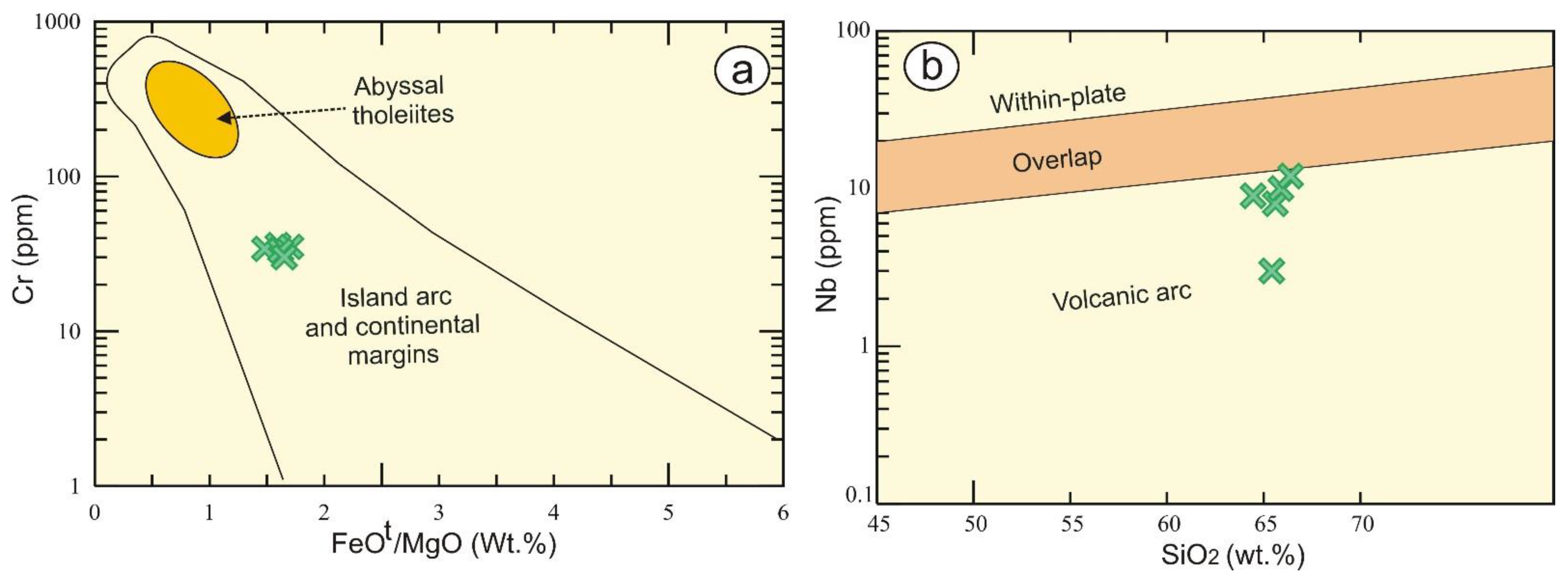An Extended Investigation of High-Level Natural Radioactivity and Geochemistry of Neoproterozoic Dokhan Volcanics: A Case Study of Wadi Gebeiy, Southwestern Sinai, Egypt
Abstract
:1. Introduction
2. Geological Setting
3. Material and Methods
4. Petrography
5. Results
5.1. Geochemical Characteristics of Unaltered Rocks
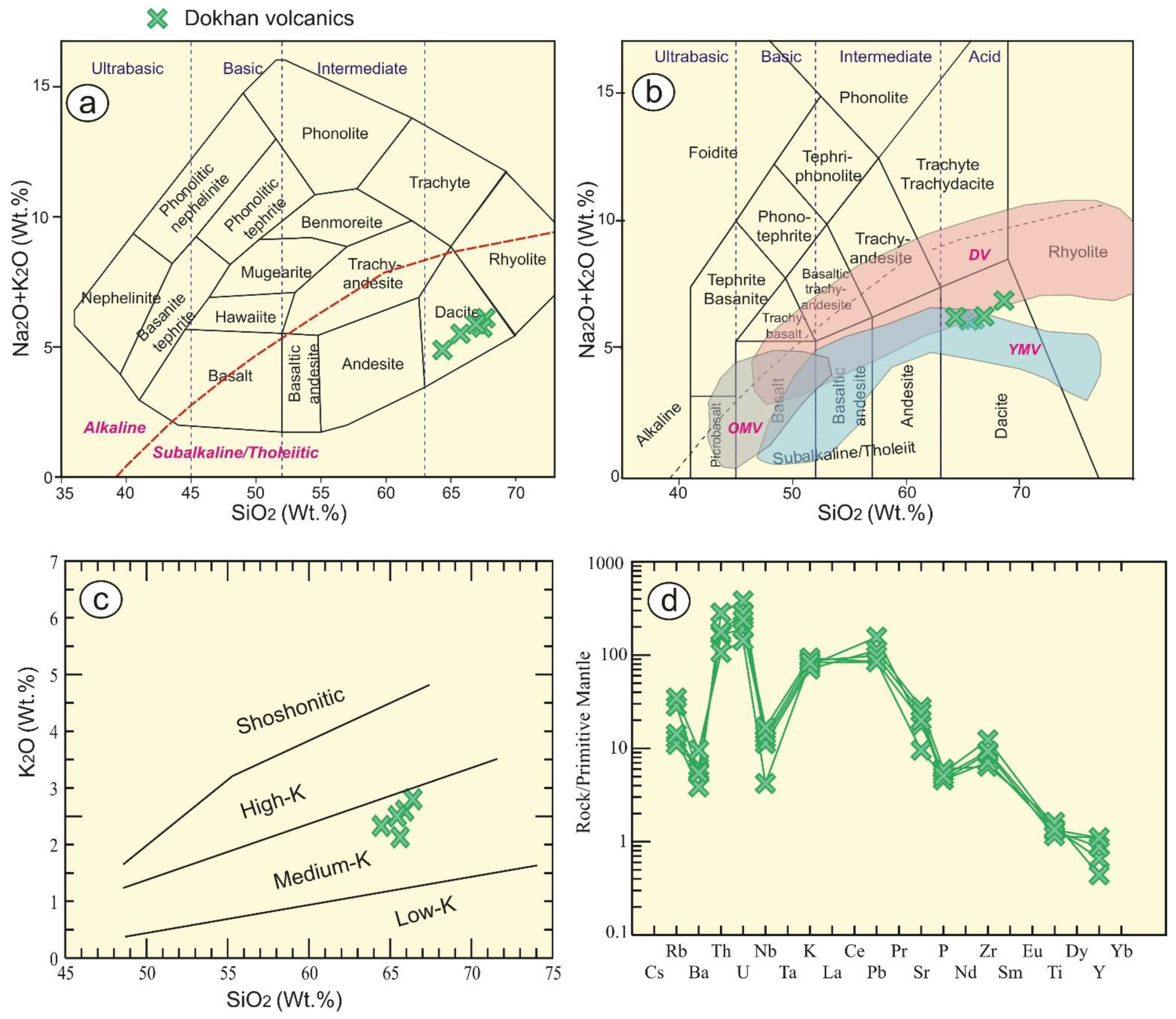
5.2. Geochemistry of the Altered Rocks
6. Discussion
6.1. Tectonic Setting
6.2. Radiometric Measurements
6.3. Radionuclides Activity and Radiological Hazards
6.4. Mineralization
6.4.1. Silicate Minerals
6.4.2. Non-Silicate Minerals
6.5. Origin of Uranium Mineralizations
7. Conclusions
Author Contributions
Funding
Data Availability Statement
Conflicts of Interest
References
- Lasheen, E.S.R.; Saleh, G.M.; Khaleal, F.M.; Alwetaishi, M. Petrogenesis of Neoproterozoic Ultramafic Rocks, Wadi Ibib—Wadi Shani, South Eastern Desert, Egypt: Constraints from Whole Rock and Mineral Chemistry. Appl. Sci. 2021, 11, 10524. [Google Scholar] [CrossRef]
- Saleh, G.M.; Khaleal, F.M.; Lasheen, E.S.R. Geochemistry and paleoweathering of metasediments and pyrite-bearing quartzite during the Neoproterozoic Era, Wadi Ibib-Wadi Suwawrib, South Eastern Desert, Egypt. Arab. J. Geosci. 2022, 15, 51. [Google Scholar] [CrossRef]
- Maurice, A.E.; Bakhit, B.R.; Basta, F.F.; Asimow, P.D.; Wälle, M.; Azer, M.K.; El-Sobky, A.F. The last subduction-related volcanism in the northern tip of the Arabian Nubian Shield: A Neoproterozoic arc preceding the terminal collision of East and West Gondwana. Precambr. Res. 2018, 310, 256–277. [Google Scholar] [CrossRef]
- Breitkreuz, C.; Eliwa, H.; Khalaf, I.; El Gameel, K.; Bühler, B.; Sergeev, S.; Larionov, A.; Murata, M. Neoproterozoic SHRIMP U-Pb zircon ages of silica-rich Dokhan Volcanics in the North Eastern Desert, Egypt. Precambr. Res. 2010, 182, 163–174. [Google Scholar] [CrossRef]
- El-Gaby, S.; Khudeir, A.A.; Abdel Tawab, M.; Atalla, R.F. The metamorphosed volcano-sedimentary succession of Wadi Kid, Southeastern Sinai Egypt. Ann. Geol. Survey Egypt 1991, 17, 19–35. [Google Scholar]
- Basta, E.Z.; Kotb, H.; Awadalla, M.F. Petrochemical and geochemical characteristics of the Dokhan Formation at the type locality, Jabal Dokhan, Eastern Desert, Egypt. Inst. Appl. Geol. Jeddah Bull. 1980, 3, 121–140. [Google Scholar]
- El-Gaby, S.; List, F.K.; Tehrani, R. Geology, evolution and metallogenesis of the Pan-African belt in Egypt. In The Pan-African Belt of Northeast Africa and Adjacent Areas; El-Gaby, S., Greiling, R.O., Eds.; Fried. Vieweg and Shon: Braunschweig, Germany; Wiesbaden, Germany, 1988; pp. 17–68. [Google Scholar]
- Abdel Rahman, A.M. Pan-African volcanism: Petrology and geochemistry of the Dokhan Volcanic suite in the northern Nubian Shield. Geol. Mag. 1996, 133, 17–31. [Google Scholar] [CrossRef]
- Abdel Wahed, A.A.A.; Ali, K.G.; Khalil, M.M.A.; Abdel Gawad, A.E. Dokhan volcanics of Gabal Monqul area, North Eastern Desert, Egypt: Geochemistry and petrogenesis. Arab. J. Geosci. 2012, 5, 29–44. [Google Scholar] [CrossRef]
- Obeid, M.A.; Azer, M.K. Pan-African adakitic rocks of the north Arabian-Nubian Shield: Petrological and geochemical constraints on the evolution of the Dokhan volcanics in the north Eastern Desert of Egypt. Int. J. Earth Sci. 2015, 104, 541–563. [Google Scholar] [CrossRef]
- Alzahrani, A.M.; Lasheen, E.S.R.; Rashwan, M.A. Relationship of Mineralogical Composition to Thermal Expansion, Spectral Reflectance, and Physico-Mechanical Aspects of Commercial Ornamental Granitic Rocks. Materials 2022, 15, 2041. [Google Scholar] [CrossRef]
- El Mezayen, A.M.; Heikal, M.A.; Abu Zeid, I.K.; Omar, S.A.; El-Feky, M.G.; Lasheen, E.S.R. Petrography, geochemistry and radioactivity of El-Gidami granitic Rocks, Central Eastern Desert, Egypt. Al-Azhar Bullet. Sci. Confer. 2017, 9, 25–40. [Google Scholar]
- El Mezayen, A.M.; Heikal El-Feky, M.G.; Shahin, H.; Abu Zeid, I.K.; Lasheen, E.S.R. Petrology, geochemistry, radioactivity, and M–W type rare earth element tetrads of El Sela altered granites, south eastern desert, Egypt. Acta Geochim. 2019, 38, 95–119. [Google Scholar] [CrossRef]
- El-Sayed, A.A. Geology and Distribution of Uranium and Thorium in the Basement Rock, East El-Qaa Plain Area, Sinai, Egypt. Ph.D. Thesis, Mansoura University, Mansoura, Egypt, 1997; 241p. [Google Scholar]
- Kamar, M.S. Geology, Geochemistry and Radioactivity of Gabal Serbal Area, Southwestern Sinai, Egypt. Ph.D. Thesis, Tanta University, Tanta, Egypt, 2011; 293p. [Google Scholar]
- Shapiro, L.; Brannock, W.W. Rapid analysis of silicate, carbonate and phosphate rocks. U.S. Geol. Surv. Bull. 1975, 114, A-56. [Google Scholar]
- Matolin, M. Construction and use of spectrometric calibration pads laboratory γ-ray spectrometry, NMA, Egypt. In A Report to the Government of the Arab Republic of Egypt; Project EGY/4/030-03; IAEA: Vienna, Austria, 1991; 14p. [Google Scholar]
- El Arabi, A.M.; Abbady, A.G.; Khalifa, I.H. Radioactive and Geochemistry Characteristics of the Garnetiferous Granite of Um Sleimat Area, Egypt. Online J. Earth Sci. 2007, 1, 9–20. [Google Scholar]
- Abbasi, A.; Zakaly, H.M.H.; Badawi, A. The anthropogenic radiotoxic element of 137Cs accumulate to biota in the Mediterranean Sea. Mar. Pollut. Bull. 2021, 164, 112043. [Google Scholar] [CrossRef]
- Abbasi, A.; Zakaly, H.M.H.; Algethami, M.; Abdel-Hafez, S.H. Radiological risk assessment of natural radionuclides in the marine ecosystem of the northwest Mediterranean Sea. Int. J. Radiat. Biol. 2022, 98, 205–211. [Google Scholar] [CrossRef]
- El-Taher, A.; Zakaly, H.M.H.; Elsaman, R. Environmental implications and spatial distribution of natural radionuclides and heavy metals in sediments from four harbours in the Egyptian Red Sea coast. Appl. Radiat. Isot. 2018, 131, 13–22. [Google Scholar] [CrossRef]
- Zakaly, H.M.; Uosif, M.A.; Madkour, H.; Tammam, M.; Issa, S.; Elsaman, R.; El-Taher, A. Assessment of Natural Radionuclides and Heavy Metal Concentrations in Marine Sediments in View of Tourism Activities in Hurghada City, Northern Red Sea, Egypt. J. Phys. Sci. 2019, 30, 21–47. [Google Scholar] [CrossRef]
- Zakaly, H.M.H.; Uosif, M.A.; Issa, S.; Saif, M.; Tammam, M.; El-Taher, A. Estimate the absolute efficiency by MATLAB for the NaI (Tl) detector using IAEA-314. In AIP Conference Proceedings; AIP Publishing: Yekatrinburg, Russia, 2019; Volume 2174, p. 20248. [Google Scholar]
- Cox, K.G.; Bell, J.D.; Pankhurst, R.J. The Interpretation of Igneous Rocks; Allen and Unwin: London, UK, 1979; 450p. [Google Scholar]
- Le Bas, M.J.; Le Maitre, R.W.; Streckeisen, A.; Zanettin, B. A chemical classification of volcanic rocks based on the total alkali-silica diagram. J. Petrol. 1986, 27, 745–750. [Google Scholar] [CrossRef]
- Eliwa, H.A.; Kimura, J.-I.; Itaya, T. Late Neoproterozoic Dokhan Volcanics, North Eastern Desert, Egypt: Geochemistry and petrogenesis. Precambr. Res. 2006, 151, 31–52. [Google Scholar] [CrossRef]
- Rickwood, P.C. Boundary lines within petrologic diagrams, which use oxides of major and minor elements. Lithos 1989, 22, 247–263. [Google Scholar] [CrossRef]
- Sun, S.S.; McDonough, W.F. Chemical and Isotopic Systematics of Oceanic Basalts: Implications for Mantle Composition and Processes. Geol. Soc. Lond. Spec. Publ. 1989, 42, 313–345. [Google Scholar] [CrossRef]
- Irvine, T.N.; Baragar, W.R.A. A guide to the chemical classification of the common volcanic rocks. Can. J. Earth Sci. 1971, 8, 523–548. [Google Scholar] [CrossRef]
- Cuney, M.; Leroy, J.; Volivezo, A.; Daziano, C.; Gambda, B.; Zarco, A.J.; Morello, D.; Ninci, C.; Molina, P. Metallogenesis of the uranium mineralized Achala granitic complex, Argentina: Comparison with Hercynian peraluminous leucogranites of West Europe. In Proceedings of the Technical Committee Meetings, Vienna, Austria, 9–12 March 1987; TECDOC-453. IAEA: Vienna, Austria, 1989; pp. 211–232. [Google Scholar]
- Meyer, C.H.; Hemley, T.T. Wall rock alteration. In Geochemistry of Hydrothermal Ore Deposits; Barnes, H.G., Ed.; Holt Rinehart & Winston: New York, NY, USA, 1967; pp. 166–235. [Google Scholar]
- Nesbitt, H.W.; Young, G.M. Prediction of some weathering trends of plutonic and volcanic rocks based up on thermodynamic and kinetic consideration. Geochim. Cosmochim. Acta 1984, 48, 1523–1534. [Google Scholar] [CrossRef]
- Fedo, C.M.; Young, G.M.; Nesbitt, H.W.; Hanchar, J.M. Potassic and sodic metasomatism in the Southern Province of the Canadian Shield: Evidence from the Paleoproterozoic Serpent Formation, Huronian Supergroup, Canada. Precambrian Res. 1997, 84, 17–36. [Google Scholar] [CrossRef]
- Miyashiro, A.; Shido, A. Tholeiitic and calc-alkaline series in relation to the behaviors of titanium, vanadium, chromium and nickel. Am. J. Sci. 1975, 275, 265–277. [Google Scholar] [CrossRef]
- Pearce, J.A.; Gale, G.P. Identification of ore deposition environment from trace elements geochemistry of associated igneous host rocks. Geol. Soc. Lond. Spec. Publ. 1977, 7, 14–24. [Google Scholar] [CrossRef]
- Stuckless, J.S.; Bunker, C.M.; Bush, C.A.; Doering, W.P.; Scott, J.H. Chemical and petrological studies of uraniferous granite from Granite Mountains, Wyoming U. S. Geol. Surv. J. Res. 1977, 5, 61–81. [Google Scholar]
- Hansink, J.K. Equilibrium analysis of sandstone roll front uranium deposits. In Exploration for Uranium Ore Deposits; IAEA: Vienna, Austria, 1976; pp. 638–693. [Google Scholar]
- Said, A.F.; Salam, A.M.; Hassan, S.F.; Mohamed, W.S. Assessment of the Environmental Radioactivity Impacts and Health Hazards Indices at Wadi Sahu Area, Sinai, Egypt. In Proceedings of the Tenth Radiation Physics & Protection Conference, Cairo, Egypt, 27–30 November 2010; pp. 145–159. [Google Scholar]
- UNSCEAR. Sources and Effects of Ionizing Radiation—Exposures of the Public and Workers from Various Sources of Radiation—UNSCEAR 2008 Report; United Nations: New York, NY, USA, 2010. [Google Scholar]
- UNSCEAR. Exposures from natural radiation sources (Annex B). Sources Eff. Ioniz. Radiat. 2000, 9, 84–141. [Google Scholar]
- Lasheen, E.S.R.; Rashwan, M.A.; Osman, H.; Alamri, S.; Khandaker, M.U.; Hanfi, M.Y.M. Radiological Hazard Evaluation of Some Egyptian Magmatic Rocks Used as Ornamental Stone: Petrography and Natural Radioactivity. Materials 2021, 14, 7290. [Google Scholar] [CrossRef]
- Ravisankar, R.; Chandramohan, J.; Chandrasekaran, A.; Prince Prakash Jebakumar, J.; Vijayalakshmi, I.; Vijayagopal, P.; Venkatraman, B. Assessments of radioactivity concentration of natural radionuclides and radiological hazard indices in sediment samples from the East coast of Tamilnadu, India with statistical approach. Mar. Pollut. Bull. 2015, 15, 419–430. [Google Scholar] [CrossRef] [PubMed]
- Hazou, E.; Patchali, T.E. Case Studies in Chemical and Environmental Engineering Assessment of radiological hazards in the phosphate mining area of Kpogam’e, Togo. Case Stud. Chem. Environ. Eng. 2021, 3, 100077. [Google Scholar] [CrossRef]
- Nininger, R.D. Minerals for Atom Energy, 1st ed.; David Van Nostrand Co., Inc.: Princeton, NJ, USA, 1954; 367p. [Google Scholar]
- Speer, J.A. Mica in igneous rocks. Am. Miner. Soc. Monograph. 1984, 15, 299–356. [Google Scholar]
- Deer, W.A.; Howie, R.A.; Zussman, J. An Introduction to the Rock Forming Minerals, 2nd ed.; Longman Scientific and Technical: London, UK, 1992; 696p. [Google Scholar]
- Graeser, S.; Schwander, H.; Stalder, H.A. A solid solution series between xenotime (YtPO4) and chernovite (YtAsO4). Mineral. Mag. 1973, 39, 145–151. [Google Scholar] [CrossRef]
- El-Kammar, A.; El-Aassy, I.E.; Abram, F.B. Rare earth elements geochemistry and crystal chemistry of xenotime-bearing sediments of Um Bogma area, Southwestern Sinai, Egypt. Chem. Der Erde 1997, 57, 91–101. [Google Scholar]
- Berry, L.G.; Mason, B. Mineralogy, 2nd ed.; W. H. Freeman and Company: San Francisco, CA, USA, 1983; 561p. [Google Scholar]
- Sami, K.A.; Omar, A. Exploration of uranium and mineral deposits using remote sensing data and GIS applications, Serbal area, Southwestern Sinai, Egypt. Arab. J. Geosci. 2021, 14, 2214. [Google Scholar] [CrossRef]
- Sarcia, J.A. The uraniferous province of northern limousin and its three principal deposits. In Peaceful Uses of Atomic Energy; International Atomic Energy Agency (IAEA): Vienna, Austria, 1958; Volume 2. [Google Scholar]
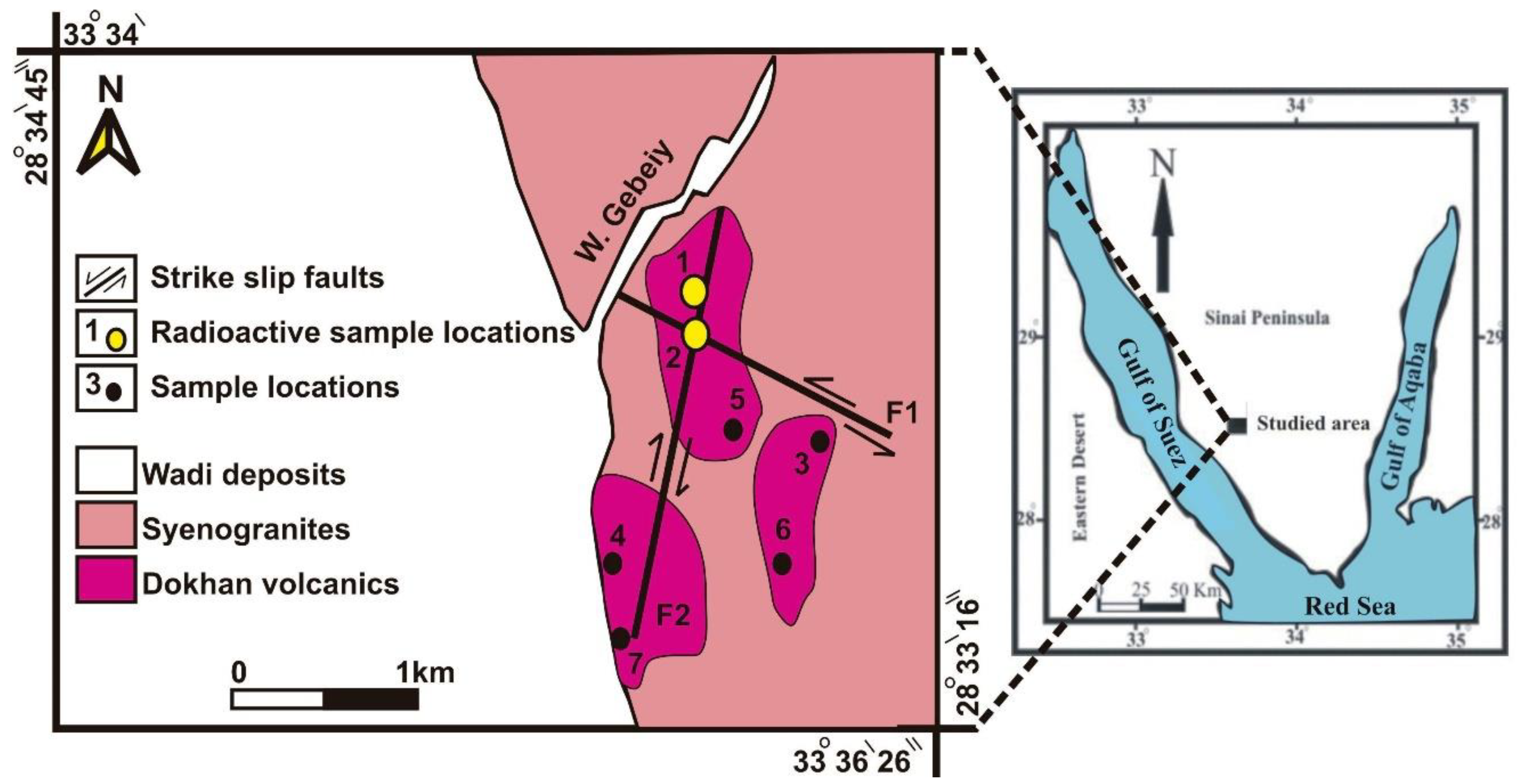
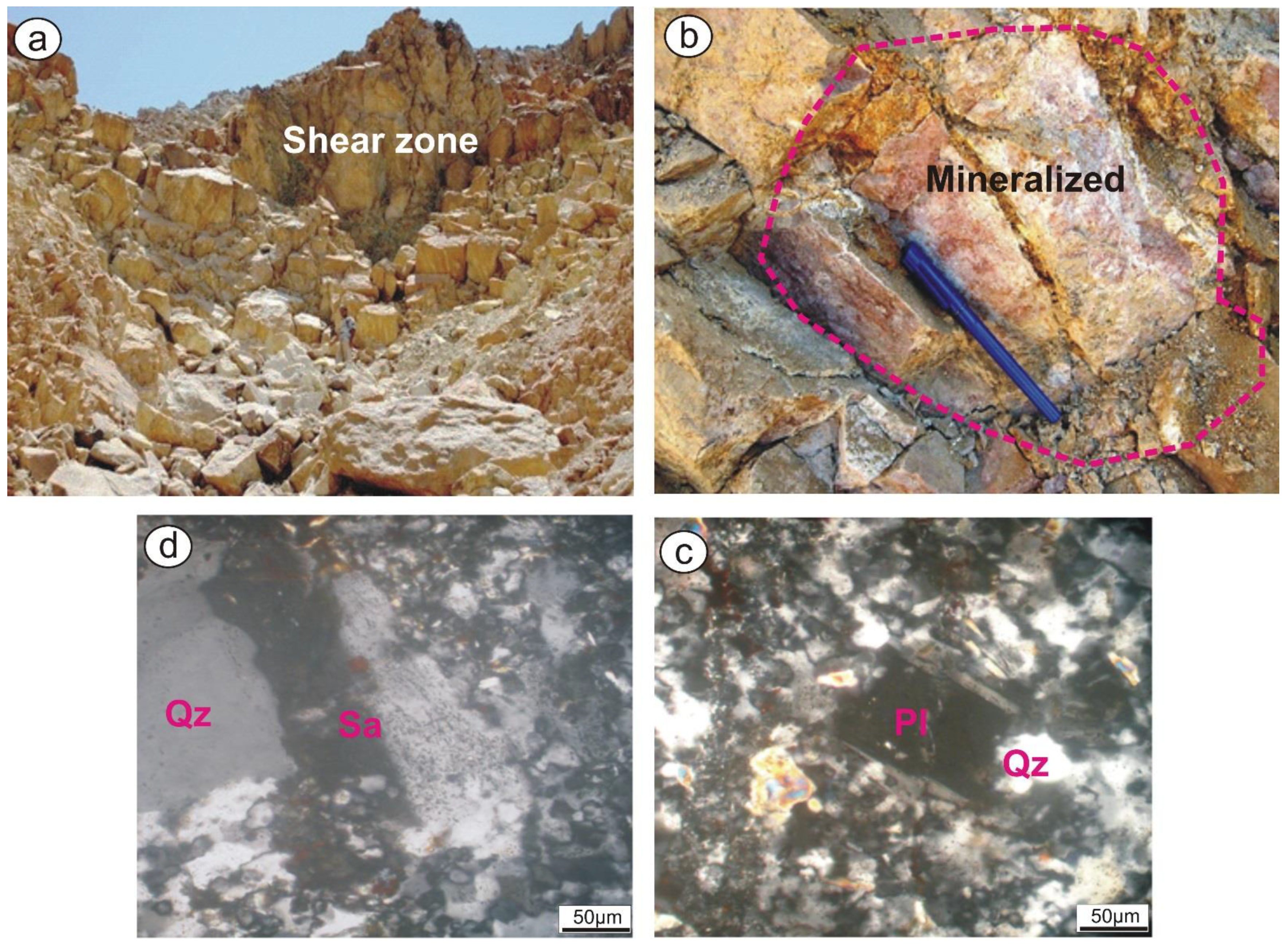

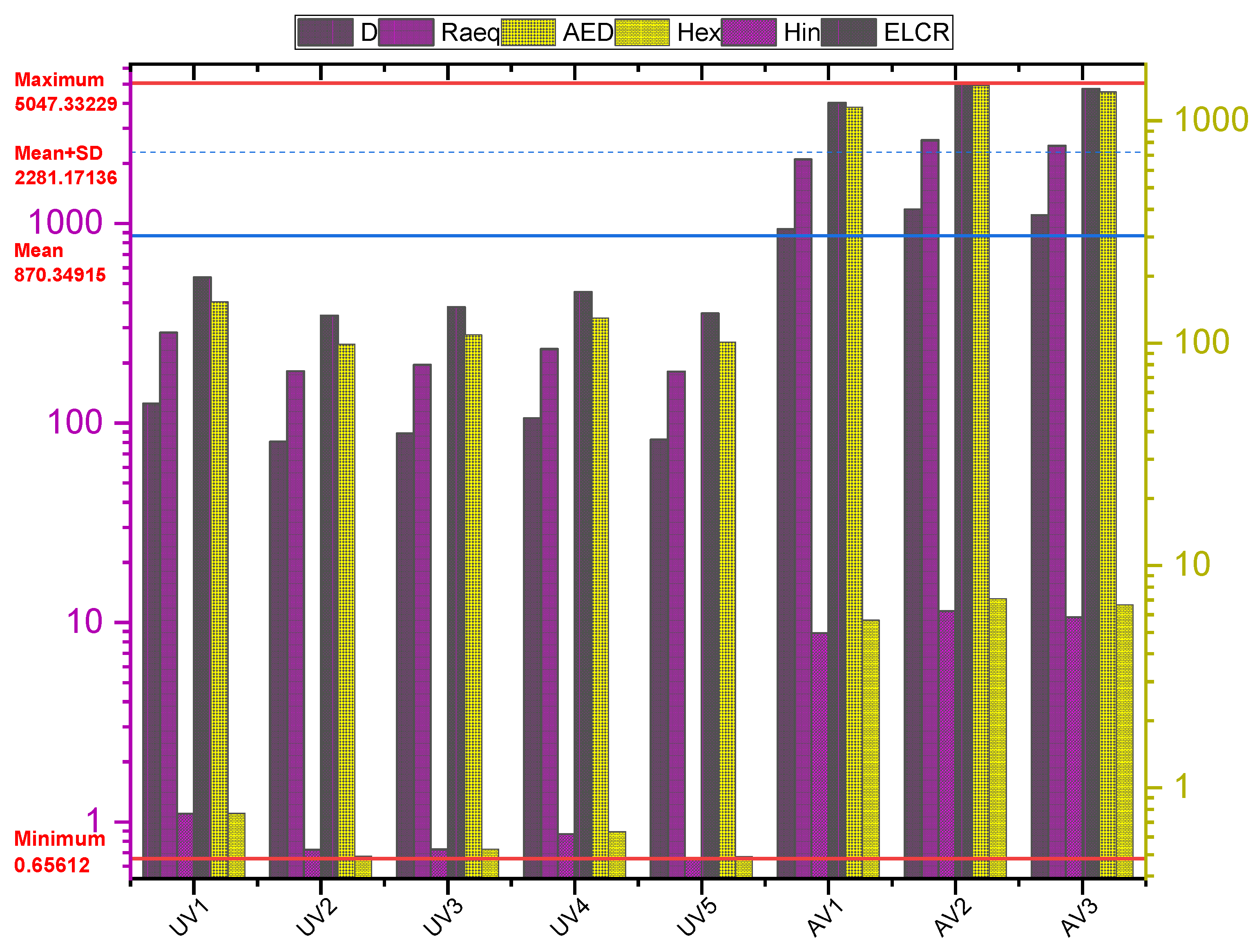
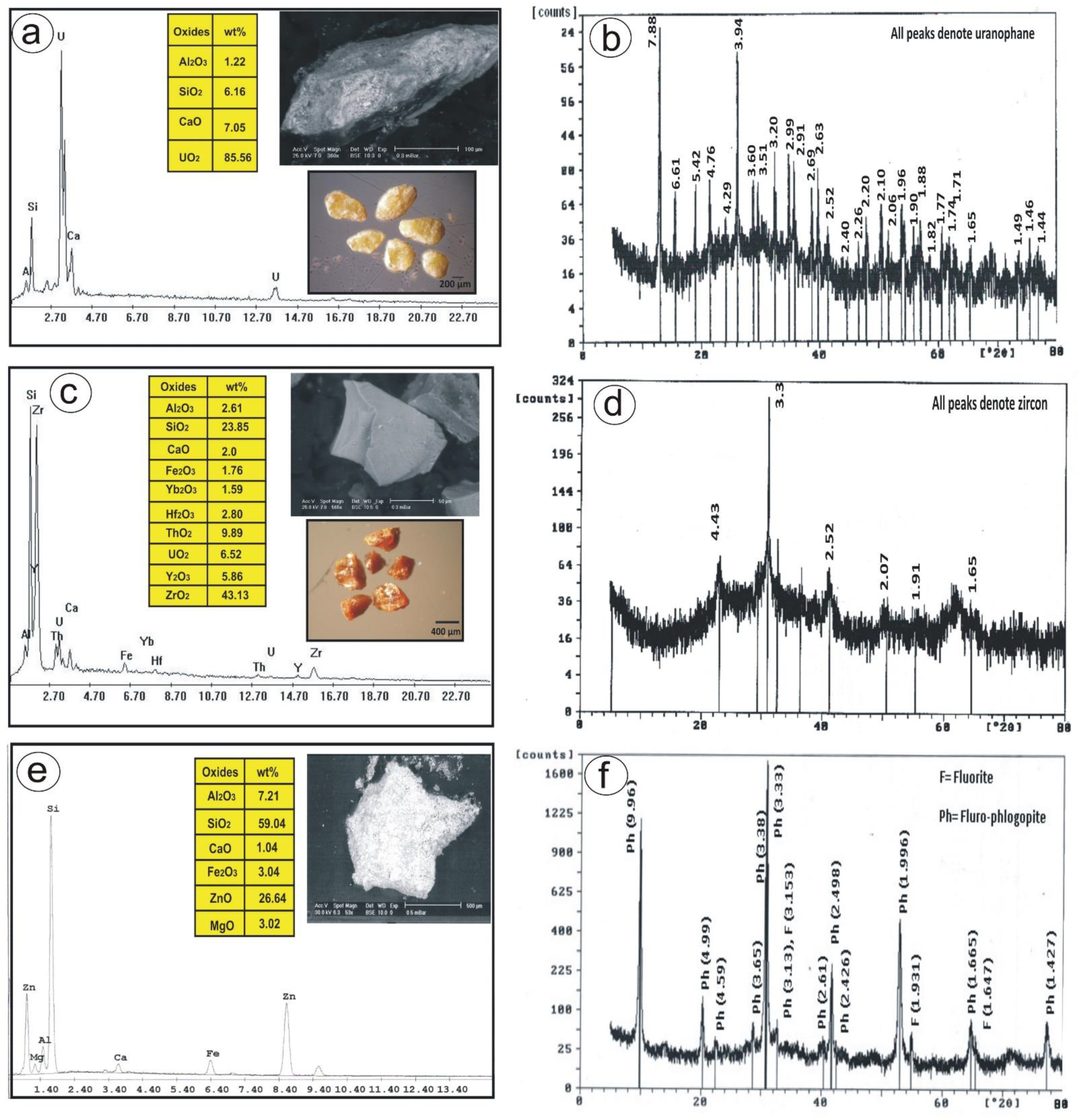

| Unaltered Volcanic Rocks | Altered Volcanic Rocks | |||||||
|---|---|---|---|---|---|---|---|---|
| SiO2 | 64.46 | 65.61 | 65.90 | 66.40 | 65.43 | 60.29 | 60.26 | 60.02 |
| TiO2 | 0.30 | 0.35 | 0.28 | 0.25 | 0.29 | 0.25 | 0.26 | 0.26 |
| Al2O3 | 15.69 | 14.60 | 15.70 | 14.10 | 15.67 | 16.95 | 16.58 | 16.21 |
| Fe2O3 | 3.87 | 3.87 | 3.97 | 3.39 | 3.70 | 3.69 | 3.90 | 4.10 |
| FeO | 0.12 | 0.13 | 0.13 | 0.11 | 0.10 | 0.11 | 0.11 | 0.10 |
| MgO | 2.50 | 2.70 | 2.40 | 2.16 | 2.30 | 2.10 | 2.15 | 2.20 |
| CaO | 5.60 | 5.50 | 5.40 | 4.10 | 5.20 | 6.20 | 6.20 | 6.20 |
| Na2O | 3.16 | 3.06 | 3.30 | 3.40 | 3.26 | 3.78 | 3.29 | 3.59 |
| K2O | 2.33 | 2.13 | 2.60 | 2.80 | 2.50 | 4.17 | 4.07 | 4.37 |
| P2O5 | 0.12 | 0.13 | 0.10 | 0.10 | 0.11 | 0.10 | 0.11 | 0.11 |
| L.O.I | 1.54 | 1.13 | 1.10 | 1.50 | 1.50 | 2.30 | 2.47 | 2.64 |
| Cr | 36.00 | 34.00 | 35.00 | 33.00 | 30.00 | 30.00 | 31.00 | 32.00 |
| Ni | 6.00 | 5.00 | 5.00 | 4.00 | 7.00 | 4.00 | 4.50 | 5.00 |
| Cu | 35.00 | 34.00 | 30.00 | 28.00 | 34.00 | 14.00 | 15.00 | 16.00 |
| Zn | 46.00 | 21.00 | 20.00 | 18.00 | 34.00 | 12,251.00 | 14,310.00 | 16,469.00 |
| Zr | 138.00 | 72.00 | 80.00 | 99.00 | 104.00 | 147.00 | 140.00 | 129.00 |
| Rb | 8.00 | 7.00 | 9.00 | 18.00 | 22.00 | 34.00 | 34.50 | 35.00 |
| Y | 3.00 | 2.00 | 4.00 | 5.00 | 5.00 | 15.00 | 15.50 | 16.00 |
| Ba | 27.00 | 44.00 | 40.00 | 38.00 | 67.00 | 2.00 | 2.00 | 2.00 |
| Pb | 11.00 | 8.00 | 7.00 | 6.00 | 6.00 | 658.00 | 799.00 | 938.00 |
| Sr | 375.00 | 578.00 | 510.00 | 420.00 | 201.00 | 307.00 | 294.50 | 282.00 |
| Ga | 19.00 | 26.00 | 22.00 | 18.00 | 21.00 | 20.00 | 18.00 | 16.00 |
| V | 22.00 | 27.00 | 25.00 | 20.00 | 19.00 | 33.00 | 19.50 | 6.00 |
| Nb | 9.00 | 8.00 | 10.00 | 12.00 | 3.00 | 31.00 | 30.50 | 30.00 |
| U | 8.00 | 6.00 | 4.00 | 5.00 | 3.00 | 161.00 | 175.50 | 190.00 |
| Th | 24.00 | 15.00 | 14.00 | 15.00 | 9.00 | 119.00 | 122.50 | 126.00 |
| Unaltered Volcanic Rocks | Av. | Altered Volcanic Rocks | Av. | |||||||
|---|---|---|---|---|---|---|---|---|---|---|
| eU (ppm) | 10 | 7 | 6 | 7 | 5 | 7 | 95 | 130 | 120 | 115 |
| eTh (ppm) | 27 | 16 | 16 | 21 | 15 | 19 | 150 | 165 | 158 | 157.67 |
| (Ra) (ppm) | 11 | 6 | 5 | 4 | 3 | 5.8 | 70 | 82 | 78 | 76.67 |
| K% | 0.16 | 0.1 | 1.2 | 1.1 | 1.34 | 0.78 | 2.2 | 2.3 | 2.24 | 2.25 |
| Uch (ppm) | 8 | 6 | 4 | 5 | 3 | 5.2 | 161 | 190 | 175 | 175.33 |
| Thch (ppm) | 24 | 15 | 14 | 15 | 9 | 15.4 | 119 | 126 | 122 | 122.33 |
| eU/eRa | 0.91 | 1.17 | 1.2 | 1.75 | 1.67 | 1.21 | 1.36 | 1.59 | 1.54 | 1.5 |
| Uch/eU | 0.8 | 0.86 | 0.67 | 0.71 | 0.6 | 0.74 | 1.69 | 1.46 | 1.46 | 1.52 |
| eTh/ eU | 2.7 | 2.29 | 2.67 | 3 | 3 | 2.71 | 1.58 | 1.27 | 1.32 | 1.37 |
| eU/ eTh | 0.37 | 0.44 | 0.38 | 0.33 | 0.33 | 0.37 | 0.63 | 0.79 | 0.76 | 0.73 |
Publisher’s Note: MDPI stays neutral with regard to jurisdictional claims in published maps and institutional affiliations. |
© 2022 by the authors. Licensee MDPI, Basel, Switzerland. This article is an open access article distributed under the terms and conditions of the Creative Commons Attribution (CC BY) license (https://creativecommons.org/licenses/by/4.0/).
Share and Cite
Kamar, M.S.; Salem, I.A.; El-Aassy, I.E.; El-Sayed, A.A.; Zakaly, H.M.H.; Alzahrani, A.M.; Lasheen, E.S.R. An Extended Investigation of High-Level Natural Radioactivity and Geochemistry of Neoproterozoic Dokhan Volcanics: A Case Study of Wadi Gebeiy, Southwestern Sinai, Egypt. Sustainability 2022, 14, 9291. https://doi.org/10.3390/su14159291
Kamar MS, Salem IA, El-Aassy IE, El-Sayed AA, Zakaly HMH, Alzahrani AM, Lasheen ESR. An Extended Investigation of High-Level Natural Radioactivity and Geochemistry of Neoproterozoic Dokhan Volcanics: A Case Study of Wadi Gebeiy, Southwestern Sinai, Egypt. Sustainability. 2022; 14(15):9291. https://doi.org/10.3390/su14159291
Chicago/Turabian StyleKamar, Mohamed S., Ibrahim A. Salem, Ibrahim E. El-Aassy, Abdu A. El-Sayed, Hesham M.H. Zakaly, Abdullah M. Alzahrani, and El Saeed R. Lasheen. 2022. "An Extended Investigation of High-Level Natural Radioactivity and Geochemistry of Neoproterozoic Dokhan Volcanics: A Case Study of Wadi Gebeiy, Southwestern Sinai, Egypt" Sustainability 14, no. 15: 9291. https://doi.org/10.3390/su14159291
APA StyleKamar, M. S., Salem, I. A., El-Aassy, I. E., El-Sayed, A. A., Zakaly, H. M. H., Alzahrani, A. M., & Lasheen, E. S. R. (2022). An Extended Investigation of High-Level Natural Radioactivity and Geochemistry of Neoproterozoic Dokhan Volcanics: A Case Study of Wadi Gebeiy, Southwestern Sinai, Egypt. Sustainability, 14(15), 9291. https://doi.org/10.3390/su14159291








